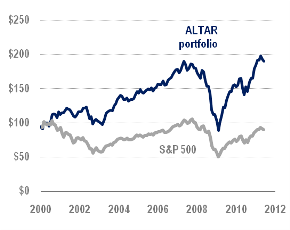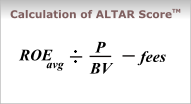How we rate ETFs
Investing is about the future. Our ETF rating works by helping you find value going forward, not simply telling you what has performed well until now. For each ETF we cover, we calculate an ALTAR Score™—short for AltaVista Long Term Annual Return forecast (explained below)—that summarizes the results of our fundamentally-driven analysis. Finally, we distill it into five simple tiers: SPECULATIVE, OVERWEIGHT, NEUTRAL, UNDERWEIGHT, and AVOID.
How this benefits investors
Ultimately the goal of research is to help investors make money. Any rating system simply summarizes the findings of the research into a single number or grade, allowing readers to narrow their search. Of the many benefits of our approach, the most important one is that it works, both in hypothetical back tests and real-world results.
Back-tested results
Because most ETFs have very limited history, it is impossible to measure directly how the ALTAR Score™ would have fared over a lengthy time period. However, the concept applies equally well to single stocks. In order to test its validity in the real world we created a simple portfolio consisting of the 100 stocks in the S&P500 with the highest ALTAR Scores™ on January 1 of each year and held the cap-weighted portfolio for one year. At the beginning of each new year the process was repeated.
 |
The graph on the left illustrates the results. A hypothetical ALTAR™ portfolio of $100 would have grown to $179 (price appreciation) between the start of 2000 and the end of 2010, compared with a decline in value to $86 for the original investment in the S&P 500. Real world resultsOur model ETF portfolios, constructed using our proprietary research, including the ATLAR Score™, have each significantly outperformed their benchmarks over the four years since inception. Although this history is not as lengthy as the back test, results are an important validation that the concept works in the real world, helping investors make better index selections. Press release here. |
ALTAR Score™
 The AltaVista Long Term Annual Return forecast, or ALTAR Score™, is our proprietary measure of an ETF's overall investment merit. It is calculated by the formula on the right, where Avg. ROE is the average return on equity of the companies in the fund for the five (5) years leading up to and including the current-year forecast; P/BV is the price-to-book value based on current market prices; and fees is the annual expense ratio of the ETF.
The AltaVista Long Term Annual Return forecast, or ALTAR Score™, is our proprietary measure of an ETF's overall investment merit. It is calculated by the formula on the right, where Avg. ROE is the average return on equity of the companies in the fund for the five (5) years leading up to and including the current-year forecast; P/BV is the price-to-book value based on current market prices; and fees is the annual expense ratio of the ETF.
The ALTAR Score™ is designed to forecast the likely internal rate of return to owners and as such facilitates comparisons between funds, both within a given category or across categories. Investors should consider buying ETFs with relatively high scores, and selling or avoiding those with low scores.
However it is not a prediction of what the market price might be at some point in the future, or a "target price." Rather it helps answer the question, "If I had enough money to buy the business(es) outright and operate them for my own benefit, what kind of returns could I expect on my investment?"
How is the ALTAR Score™ different from competing rating systems?
Most competitors' ratings are based on past performance. As a result, they encourage investors to allocate assets to areas that have already increased in price significantly, and away from those that have already fallen. This is a buy high, sell low strategy.
The ALTAR Score™ works differently by encouraging investors to dynamically allocate assets away from areas that may be overheated (where fundamentals have not kept pace with price increases) and into areas of more value (where prices may not fully reflect underlying fundamentals).
![]() For an in-depth discussion of the ALTAR Score™, advantages and academic foundations, download our Research of ETFs guidebook.
For an in-depth discussion of the ALTAR Score™, advantages and academic foundations, download our Research of ETFs guidebook.
